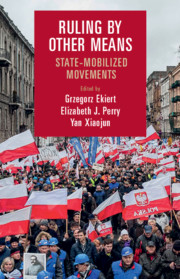Book contents
- Ruling by Other Means
- Cambridge Studies in Contentious Politics
- Ruling by Other Means
- Copyright page
- Contents
- Figures
- Tables
- Contributors
- Acknowledgments
- 1 State-Mobilized Movements: A Research Agenda
- 2 Manufactured Ambiguity
- 3 Suppressing Students in the People’s Republic of China
- 4 State-Mobilized Community Development
- 5 Enforcement Networks and Racial Contention in Civil Rights–Era Mississippi
- 6 Social Sources of Counterrevolution
- 7 Occupy Youth!
- 8 State-Mobilized Movements after Annexation of Crimea
- 9 Mirroring Opposition Threats
- 10 Mobilizing against Change
- 11 The Dynamics of State-Mobilized Movements
- 12 State-Mobilized Campaign and the Prodemocracy Movement in Hong Kong, 2013–2015
- 13 The Resurrection of Lei Feng
- Index
- Books in the Series (continued from p.iii)
- References
13 - The Resurrection of Lei Feng
Rebuilding the Chinese Party-State’s Infrastructure of Volunteer Mobilization
Published online by Cambridge University Press: 29 July 2020
- Ruling by Other Means
- Cambridge Studies in Contentious Politics
- Ruling by Other Means
- Copyright page
- Contents
- Figures
- Tables
- Contributors
- Acknowledgments
- 1 State-Mobilized Movements: A Research Agenda
- 2 Manufactured Ambiguity
- 3 Suppressing Students in the People’s Republic of China
- 4 State-Mobilized Community Development
- 5 Enforcement Networks and Racial Contention in Civil Rights–Era Mississippi
- 6 Social Sources of Counterrevolution
- 7 Occupy Youth!
- 8 State-Mobilized Movements after Annexation of Crimea
- 9 Mirroring Opposition Threats
- 10 Mobilizing against Change
- 11 The Dynamics of State-Mobilized Movements
- 12 State-Mobilized Campaign and the Prodemocracy Movement in Hong Kong, 2013–2015
- 13 The Resurrection of Lei Feng
- Index
- Books in the Series (continued from p.iii)
- References
Summary
Following the Sichuan earthquake of 12 May 2008, hundreds of thousands of volunteers spontaneously joined the relief effort – a loosely organized grassroots movement that caught both the Chinese government and international observers by surprise. A few months later, at the Beijing Olympic games, over 100,000 well-organized volunteers efficiently catered to the needs of visitors. With these two events, volunteerism became visible as a mass phenomenon in China. From then on, the state gave volunteering an increased level of support and legitimacy, in order to promote and channel volunteering as a form of social service. The Communist Party Youth League and the Ministry of Civil Affairs, with their networks reaching down to student cells in schools and residents’ committees in the neighbourhoods, developed increasingly comprehensive and systematic programmes to recruit and deploy volunteers to care for the elderly, help out at major sporting and diplomatic events, give tutoring support for migrant children, engage in environmental cleanups, or travel as volunteer teachers to remote rural and ethnic minority regions.
- Type
- Chapter
- Information
- Ruling by Other MeansState-Mobilized Movements, pp. 314 - 344Publisher: Cambridge University PressPrint publication year: 2020
References
- 11
- Cited by

